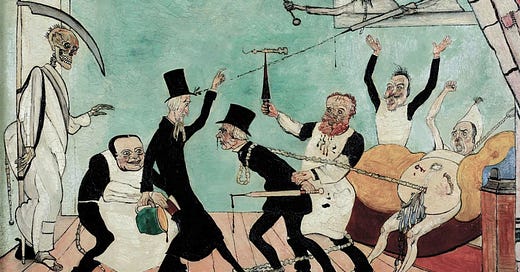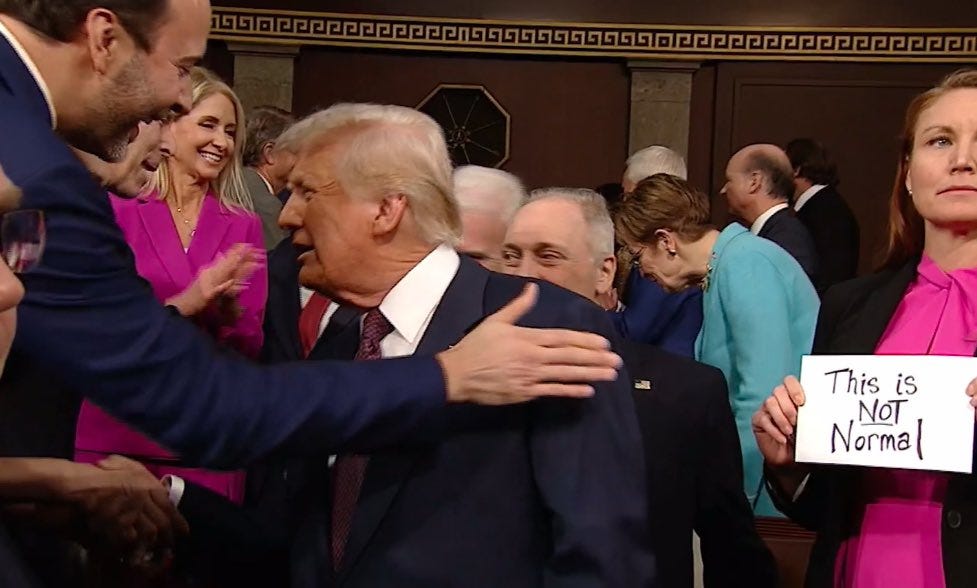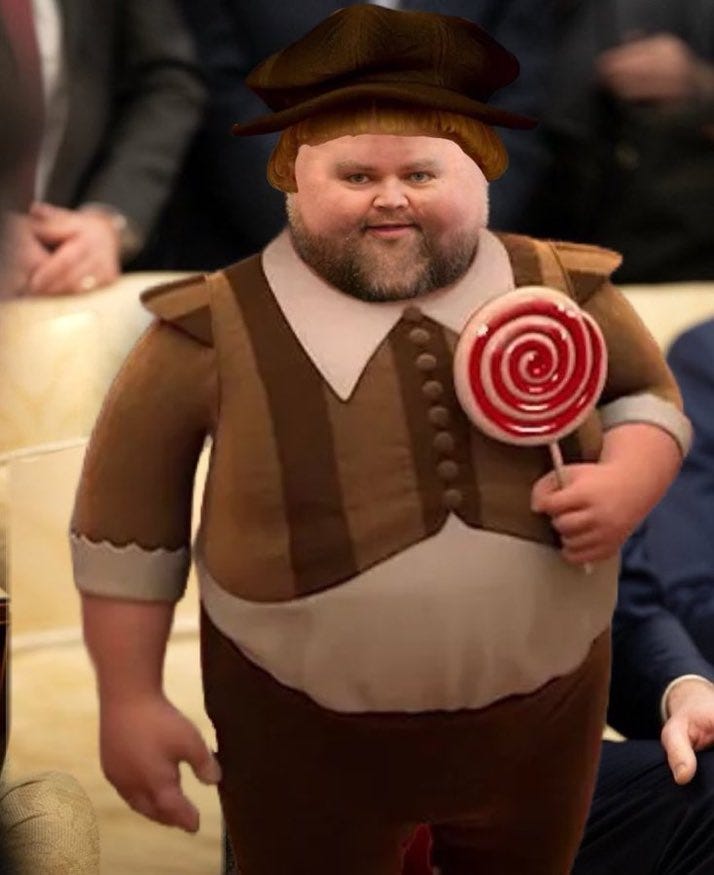We’ve been close before, real close, but Trump and J.D. Vance attacking Zelensky in the Oval Office last week sealed the deal.
Welcome, one and all, to the age of grotesque.
If you haven’t watched the video above, god bless you. I envy that, because it was one of the least dignified and foul things I’ve had the misfortune of seeing — and I grew up an internet unaware of the concept of “content moderation.”
But here’s the thing that everyone misses about the Trump and Zelensky confrontation. This isn’t grotesqueness in a silo or nastiness for the sake of it. Instead, it’s a chapter mark, the true beginning of an era where social media doesn’t reflect society, it runs it.
Let’s dig into this a little.
Trump is, arguably, the first major world leader to be a true poster. No matter your views on his politics, you have to admit he’s funny on social media. He’s A Guy, a character, someone who can entertain.
Part of this vibe, this humour, is in his absurdness, the fact it’s impossible to unpack how serious he is, how much he believes his own words. He balances the sincere and insincere simultaneously.
This all combined to make Trump the first Social Media President. He didn’t just use the technology, he embodied it. Think back to that first GOP debate ahead of the 2016 election where he eschewed policy discussion and basically just insulted the other candidates; a strategy plucked straight from Twitter.
The approach defined Trump’s first term, but it didn’t consume politics with its grotesqueness like it has now — and that’s because this time around, things are different.
When Trump won the presidency in 2016, his VP was Mike Pence. A weirdo, sure, but someone who was a more traditional Republican. He kept elements of the party grounded, and was even an underappreciated cog in stopping Trump’s attempted coup on January 6th.
As Notorious B.I.G. put it though, things done changed. The Republican party was reshaped. Trump enacted an exodus of “disloyal” people, with many who opposed parts of his first term thrown to the wind.
All this laid the groundwork for where we are now: no longer the first Social Media President, but the first Social Media Party.
Let’s define what a Social Media Party is. It’s not about the age range of politicians like J.D. Vance, who spent parts of their youth on the internet. Nor is it about being “online,” something Elon Musk desperately covets. Neither is it about jokes or making silly videos.
A Social Media Party is an approach to politics, it’s about plumbing depths, being combative, and realising that nothing really matters any more. The only truth is engagement. Opinion outstrips everything. Where legacy media has factcheckers and is accountable to law, Facebook and other platforms abandon the idea of objective reality entirely.
Which brings us to the Zelensky meeting.
What we witnessed wasn’t traditional politics, a show of respect and manners in all circumstances. It was a live action version of Twitter; bickering, rude, and grotesque. It was the actions of a Social Media Party.
The behaviour we see online was transferred into the Oval Office, not just by Trump as in years gone by, but by the whole political apparatus. This was summed up perfectly by the man who shouted at Zelensky, demanding to know why he’s not wearing a suit.
The questioner is a bellcrease called Brian Glenn. While he’s listed as“journalist,” in reality he’s really Rep. Marjorie Taylor Greene’s boyfriend.
Is there anything more social media than that? A random fucking guy who shouldn’t be there shouting an off-topic remark to a famous figure?
Society and politics used to influence what happened online, but now how people act on social media is copied by politicians. It’s not what many of us would’ve wanted from the 21st century.
So far, so clear. Politics is now grotesque. This grotesqueness is influenced by social media. But so what?
Well, the issue is that groups on the left have no goddamn idea how to combat this inaugural Social Media Party.
And the answer is surprisingly simple: they need to fully embrace social media too.
I’m sure many Democrats think they already have. When Trump addressed a joint session of Congress at the US Capitol earlier this week, some Democrats wore pink to protest. One of them even held up a sign:
This, I’m sorry to say, is some boomer-ass, flashmob-loving, Drumpf-saying bullshit. That’s not social media; that’s just what people who spend no time online think social media is.
Democrats are acting like typical politicians, thinking that decrying Trump and Vance and their actions will do something — but that’s not how the internet works. And that’s where these people need to look if they’re going to put up any sort of resistance.
This begs a question: what happens when someone acts grotesquely online? How do you fight that?
Through mockery, through inversion, through bending the grotesque to your own end.
Let’s use an example that’s currently taking over the internet: the J.D. Vance “babyface” and “have you said thank you once” memes. Following his outburst at Zelensky, the online world has taken great joy in mocking him.
The most impactful way of doing this isn’t posting calling him a monster or saying he’s wrong, it’s through image manipulation.
If you go on Twitter, these J.D. Vance memes are incredibly popular, flooding people’s feeds. They zero on what makes him so distasteful without needing words or strategy. Everything the man oozes is somehow distilled into these pictures:
Vance is an online bully, a two-pence troll that revels in winding people up. Trying to argue with him plays into his hand. These figures want nothing more than the validation of your frustration, it shows they’re winning, that they’ve got to you. It’s the oldest trick in the social media playbook.
The trick is to skip that step. To not respond, but invert. To mock and belittle, to hit him where it hurts. Because if there’s one thing I can say for sure, it’s that he will not be a fan of these pictures.
Traditional politics is gone, and it seems the only people who recognise this are those on the right. If grotesqueness is to be countered, it must be done so with subversion and, importantly, A Guy. A Very Online Guy.
What I mean by that isn’t gendered, but the energy of a poster, someone who can cut through what Trump and Vance do. As silly as it sounds, the Democrats need a Bill Burr character, someone who straight-up says that billionaires should be put down like rabid dogs and calls Elon Musk a Nazi. A charismatic figure, someone who understands the social media tactics of Trump’s team.
The concern, of course, is that this will pull politics into a terrible place, but I’d retort with this: where do you think we already are?
Trying to fight the grotesqueness of the world by pointing and saying, “look how ugly that is” won’t work. That’s the point, the ugliness and the grotesqueness is the point.
The only way to fight a Social Media Party is to become a Social Media Party. But, hopefully, a good one, like the Menswear Guy on Twitter.
Politics as we know it is dead. It was a long time coming. And maybe, just maybe, the opposition to figures like Trump should start acting like real people instead of politicians.
Unless they fight like A Very Online Guy, they’ll continue to get ratio’d on the important topics.






![[succ] Go directly to the solutions tent, do not collect 600 dollars ... [succ] Go directly to the solutions tent, do not collect 600 dollars ...](https://substackcdn.com/image/fetch/$s_!bqdI!,w_1456,c_limit,f_auto,q_auto:good,fl_progressive:steep/https%3A%2F%2Fsubstack-post-media.s3.amazonaws.com%2Fpublic%2Fimages%2Fb59076af-fef3-40fd-8001-84aae3e7e2bf_679x363.jpeg)




